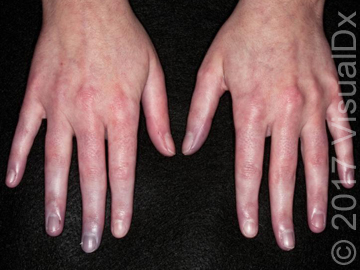Photo courtesy of VisualDx.
Raynaud phenomenon is a vascular disorder characterized by intermittent arteriolar vasospasm of the digits, most often due to cold temperature or stress. Symptoms present with characteristic changing of hands from white (pallor) to blue (cyanosis) to red (hyperemia), although all 3 phases may not be present in each individual. Raynaud phenomenon may be primary or secondary.
Primary Raynaud phenomenon typically follows a less severe course than secondary Raynaud phenomenon. In primary Raynaud phenomenon, also termed Raynaud disease, vasospasm is not associated with ischemic injury or an underlying associated disease. Primary Raynaud phenomenon typically presents at a younger age (<30 years), involves all fingers symmetrically excluding the thumbs, and is not painful. Patients do not have a history of peripheral vascular disease or ischemic injury. Antinuclear antibody titers are normal or low (<1:40 on indirect immunofluorescence) and nail fold capillaries are normal.
Secondary Raynaud phenomenon is associated with an underlying disease, usually a connective tissue disease of which systemic sclerosis is the most common. Because vasospasm is associated with concurrent ischemia, attacks are typically painful and asymmetric involvement of digits or hands is common. Digital ulcerations or necrosis, digital tuft pits, pterygium inversum, and torturous nail fold capillaries with capillary dropout may be seen.
Additional associations include systemic lupus erythematosus, rheumatoid arthritis, pulmonary hypertension, frostbite, hematologic malignancies, polyvinyl chloride exposure, cryoglobulinemia, reflex sympathetic dystrophy, repeated trauma / vibration, arteriovenous fistula, intra-arterial drug administration, thoracic outlet syndrome, thromboangiitis obliterans, and Takayasu arteritis.
Source: rheumatologynetwork.com/ima...
LUpus Patients Understanding & Support (LUPUS):
